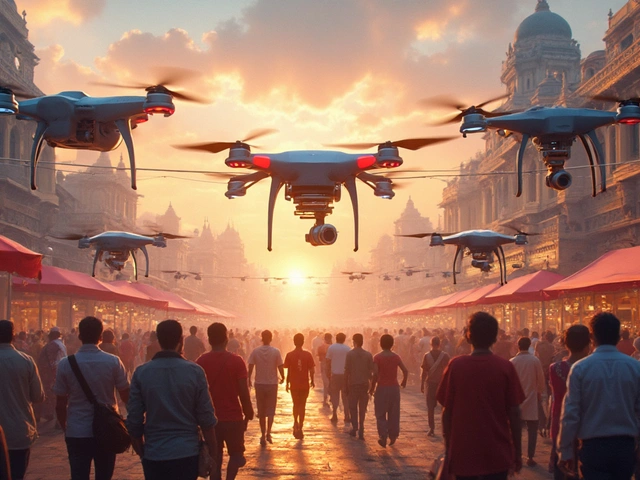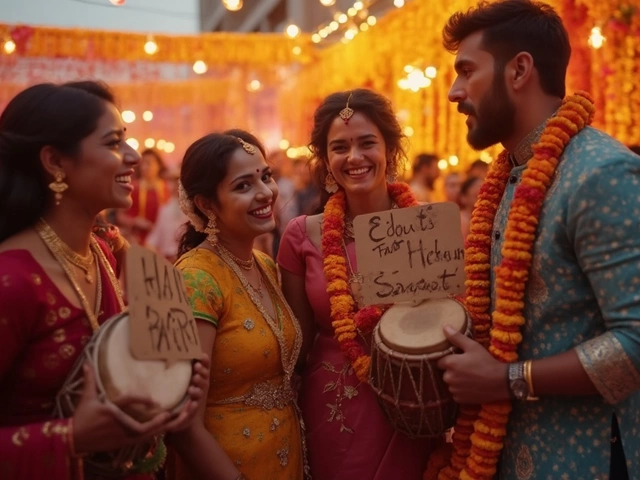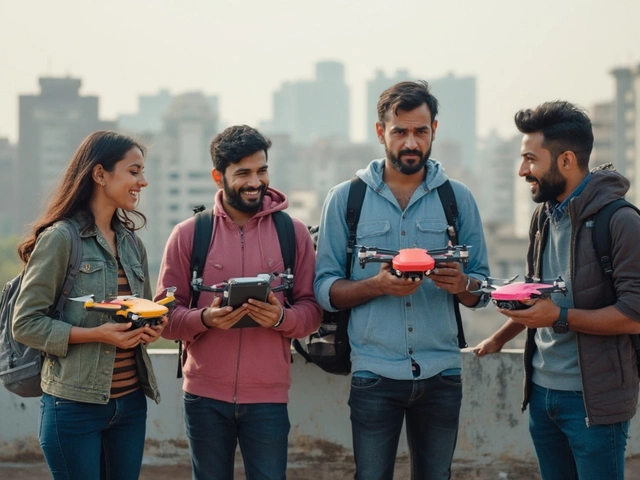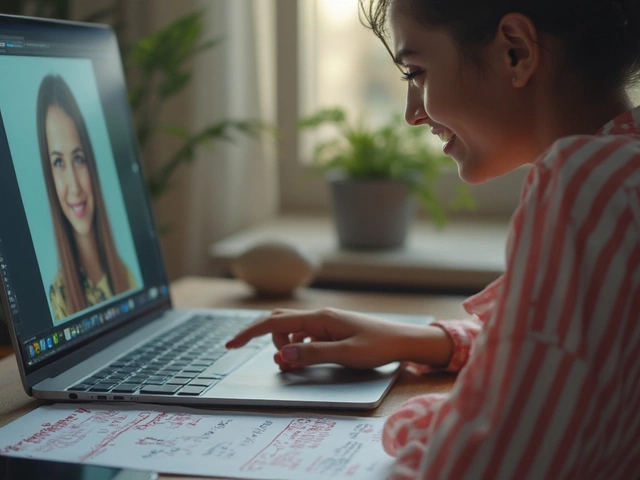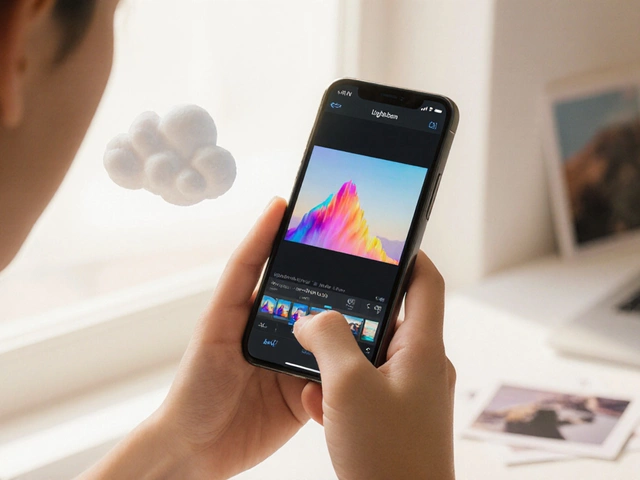As DJI drones continue to soar in popularity among photography enthusiasts in India, questions about their traceability have come to the forefront. These flying gadgets, with their remarkable capabilities, offer breathtaking aerial views unlike any other. Photographers are eager to capture India’s vibrant landscapes from the skies, but they also need to be aware of the implications of drone traceability.
So, can a DJI drone be traced? Let's unravel this question by exploring the technology that powers these drones, and what it means for privacy and security. We'll delve into how these drones can be tracked, discuss the privacy issues that might arise, and provide guidance on staying within legal boundaries while capturing stunning images. This journey will help you master the art of drone photography in India without running into trouble.
- Understanding DJI Drone Technology
- Methods of Tracing DJI Drones
- Privacy Concerns for Drone Photographers
- Legal Aspects of Drone Usage in India
- Tips for Responsible Drone Usage
- Balancing Creativity with Privacy
Understanding DJI Drone Technology
DJI drones are known for their cutting-edge technology that provides photographers in India and worldwide an opportunity to capture stunning aerial visuals. At the heart of DJI's technology is the advanced flight controller system that manages the drone's movement in the air, ensuring stability and precise control. This sophisticated system integrates GPS, which not only aids in navigation but also plays a crucial role in geo-fencing, preventing drones from entering restricted airspace. The intelligent flight systems on DJI drones are designed to make aerial photography accessible even to beginners, with features like auto takeoff and landing, and return to home.
Moreover, DJI has revolutionized the drone world with their optical sensors and obstacle avoidance technology, which significantly reduce the risk of crashes. The DJI Phantom series, for instance, includes forward and downward sensors that help the drone detect obstacles in real-time, a feature that is essential for operating in crowded or unfamiliar environments. Their drones also support various intelligent flight modes, such as ActiveTrack, which allows drones to follow subjects autonomously, making intricate shots achievable with ease.
A notable component of DJI drone technology is the real-time video transmission system, often referred to as Lightbridge, which provides a live HD view from the drone's camera to the pilot on the ground. This feature enhances the creative process, allowing photographers to frame shots with precision. A publication by 'DroneLife' highlighted, "DJI's Lightbridge system transformed the way we perceive and monitor flights, making remote control as intuitive as smartphone technology." Such innovations have made DJI a preferred choice among professional photographers and filmmakers.
Additionally, DJI drones are equipped with robust data encryption to protect user information and flights logs, a response to mounting privacy concerns. Such measures ensure that sensitive data isn’t easily accessible, providing users peace of mind as they navigate the skies over vibrant Indian cities or serene rural landscapes. With regular updates, the technology continues to evolve, integrating new features that push the boundaries of what is possible in drone photography.
For those interested in the technical aspects, DJI provides detailed specifications and user manuals online, which include flight durations, battery capacities, and payload limits across different models. A remarkable data point: the DJI Mavic 3, one of the latest models, boasts a flight time of up to 46 minutes. This kind of advancement allows photographers to explore more extensive areas without the constant need to recharge. As the technology develops, DJI remains at the forefront, innovating and expanding the possibilities of aerial imagery.
In conclusion, understanding the spectrum of technology within DJI drones is not just about grasping the mechanics but also appreciating the immense potential it offers photographers. As technology becomes more sophisticated, knowing how to effectively harness these capabilities will certainly keep you ahead in the realm of drone photography.
Methods of Tracing DJI Drones
DJI drones have captured the fascination of many, offering an unparalleled perspective of skies above. But as these drones become more widespread, the question of their traceability has gained importance. To grasp how a DJI drone can be traced, one must first understand the technology and systems these drones employ. The heart of this tracing capability lies in the GPS unit embedded within the drone. This is essential for navigation and also plays a crucial role in tracking.
Every DJI drone is equipped with advanced GPS technology that not only assists in positioning but also allows each flight path and location to be recorded. This data is invaluable for tracing and can be accessed through specific software and applications. One popular method of tracing is through the DJI Fly App, which stores flight telemetry data including the timestamped location and the drone’s altitude. Although primarily used to enhance the user experience, it also serves as a robust source for tracing.
Another aspect is the integration of ADS-B (Automatic Dependent Surveillance–Broadcast) receivers in some DJI models. This technology allows drones to receive broadcast locations and track aircraft, but it also means that drones themselves can be tracked by aviation authorities equipped with ADS-B. This becomes a two-way street where drones can be identified and monitored, contributing to safer airspace. This dual integration highlights DJI's emphasis on safety and traceability.
Moreover, some users opt for aftermarket GPS trackers which provide an extra layer of security. These devices can be attached to the drone and are especially useful in scenarios where the drone is lost or in extensive areas where retrieval might be difficult. With these trackers, responses are immediate, providing precise positioning which assists in recovery and monitoring.
However, privacy advocates express concerns regarding the extent and availability of this data. While tracking can enhance safety and accountability, it also raises questions about data access and potential misuse. A quote by Privacy International notes,
"The intersection of technology and privacy is a delicate balance, requiring transparency and caution."This perspective emphasizes the need for a mindful approach when employing tracking technology.

Privacy Concerns for Drone Photographers
Using a DJI drone to capture stunning aerial shots is exhilarating, yet it raises numerous privacy concerns for both photographers and those being photographed. The moment a drone takes flight, it becomes a flying camera able to peer into places usually considered private. These concerns are not just hypothetical; they are very real. As drones become smarter with high-resolution cameras and long flight durations, the potential for privacy violations grows. This has led to increased scrutiny from authorities and the general public.
Many countries, including India, have established regulations to address these privacy issues. India's Directorate General of Civil Aviation (DGCA) has set specific guidelines for drone operations, aimed at protecting individuals from unwanted surveillance. However, despite these regulations, the fast-paced advancement in drone technology often outpaces the legislative measures, posing a challenge for regulators and photographers alike. Users need to be well-informed about these regulations to fly their drones responsibly.
"As the adoption of drones grows, so does the necessity for a common understanding and respect for privacy," states a report from the International Association of Privacy Professionals.
The potential for misuse is another significant worry. It’s not just about the invasion of physical spaces; there's a digital aspect to consider as well. DJI drones come equipped with GPS and other data-gathering technologies that can inadvertently expose sensitive information if not properly managed. Photographers need to take control over their data, ensuring that traces from their flights don’t fall into the wrong hands. This is especially important for professionals who frequently operate in populated areas or areas of interest.
For those passionate about drone photography, respecting privacy boils down to common sense and courtesy. Knowing where you can and cannot fly is crucial, and it's vital to obtain necessary permissions when flying in restricted zones. The more seasoned photographers recommend engaging in a dialogue with locals and informing them about your activity. This can help alleviate concerns and ensure a smooth experience. Always being mindful of people's perception can mitigate fears and reduce the spread of misinformation about drones.
Tips for Safeguarding Privacy
Adhering to a few straightforward practices can enhance privacy protection. For instance, always fly below the 122-meter (400-foot) altitude cap to avoid flight paths. Use the drone’s camera in directions that avoid capturing people unnecessarily. Familiarize yourself with no-fly zones, which are typically established for airports, military bases, and areas of national security. Also, use software that encrypts your drone data to ensure private information doesn’t get leaked.
- Communicate with community members to gain local insights.
- Ensure you have the latest firmware updates, which often address security vulnerabilities.
- Utilize protective software for data encryption.
- Avoid places where people expect privacy, like backyards or through windows.
By keeping these practices in mind, photographers won’t only enhance their creativity but also foster a good relationship with their environment. Understanding the importance of privacy concerns in drone photography can lead to more responsible and acceptable use of this thrilling technology. Embracing these adjustments offers much-needed peace of mind for both photographers and the communities they are documenting.
Legal Aspects of Drone Usage in India
Flying a DJI drone in India isn't just about capturing awe-inspiring images; it's also about adhering to the legal framework established by the Directorate General of Civil Aviation (DGCA) to ensure safe and regulated operation. Since the introduction of the civil aviation requirements in 2018, India has recognized the potential of drones and has set forth explicit guidelines under the Drone Rules 2021. These rules categorize drones into different classes based on weight, such as Nano, Micro, Small, Medium, and Large, each with specific operational limitations. Understanding which category your DJI drone falls into is the first step in legal compliance.
For instance, flying a Micro drone requires you to obtain an Unmanned Aircraft Operator Permit (UAOP), which might sound daunting at first, but the process is streamlined through the Digital Sky Platform. This system is India's indigenous solution to manage drone activities within its airspace. So, even your nimble DJI drones need proper clearance before they can take to the skies legally. Staying informed about no-fly zones is crucial, especially around airports, military bases, and other sensitive locations. Violating these could result in hefty fines or even legal action, so awareness and planning are essential.
The government has also rolled out the No Permission, No Takeoff (NPNT) policy, designed to prevent unauthorized drone flights. It is a technology framework that ensures drones acquire flight permission before launching. You might be wondering, "Why such stringent rules?" The primary reason is safety. Drones can potentially interfere with manned aircraft or be used maliciously if not regulated properly. Admiring those stunning hilltop vistas should be safe for everyone involved. The DGCA continues to collaborate with technological experts to ensure drone enthusiasts can fly safely without compromising national security.
Drone expert R. K. Sood commented, "Regulations are evolving to balance innovation with public safety. It's crucial for drone users to stay updated."
Moreover, registering your DJI drone is mandatory. Each drone is assigned a Unique Identification Number (UIN), similar to a vehicle registration number. This aids in tracking and accountability, ensuring every drone in the airspace has a responsible owner. While this might seem like a hurdle, it also protects drone owners by aligning them with insurance policies that cover potential damages or accidents. Compliance with these legalities isn't just about avoiding fines; it's about embedding yourself in India's dynamic drone photography community with peace of mind.
If you're new to drone photography, familiarize yourself with the DGCA's comprehensive guide available online. They provide structured pathways for training and certification, making it easier for hobbyists and professionals alike to thrive in this exciting domain. Maverick flyers will miss out on the deeper joys of drone usage if they sidestep the legalities. Whether you're an enthusiast using your DJI drone for leisure or a professional capturing cinematic marvels, understanding and respecting the legal framework will enrich your journey through India's skies.

Tips for Responsible Drone Usage
When it comes to using DJI drones for photography in India, responsibility is the name of the game. Handling these technological marvels requires more than just knowing how to capture stunning visuals. It involves being aware of your surroundings, understanding the rules and regulations, and respecting the privacy and safety of others. A good starting point is always to familiarize yourself with the operational guidelines provided by DJI and relevant local authorities. Knowing the airspace restrictions and no-fly zones is critical, and apps available for your smartphone can assist in identifying these areas. It's essential to keep your drone within visual line of sight. Although it is tempting to push technological boundaries, seeing the drone helps you avoid accidents and ensures that you remain on the right side of the law.
Adhering to the height restrictions is another crucial aspect. In India, the Directorate General of Civil Aviation (DGCA) has clear regulations about how high a drone can fly. By sticking to these limits, you ensure you’re operating safely and legally. Also, consider others when flying your drone. Always respect private properties, and avoid flying over people or crowds, especially without permission. Privacy is an increasing concern, and maintaining trust in the technology is vital. If you are caught in a situation where you inadvertently invade someone’s space, be courteous and mindful. Offering a simple apology can sometimes go a long way. Remember, a responsible drone user is always looking to minimize risks and maximize safety.
One practical tip for keeping a check on your DJI drone’s health is by conducting regular maintenance checks. This means examining the propellers, batteries, and camera; after all, ensuring everything is in peak condition guarantees optimal performance during flights. Before every venture, double-check your drone’s battery level and weather conditions. Strong winds or rain can lead to difficulties in managing the drone, which hasn’t been designed to withstand these elements extensively. Being prepared for any mishap by having a return-to-home function properly set up can be a lifesaver in tricky situations. Understanding and making use of your drone's features, like obstacle sensing and collision avoidance, will not only improve your photography but will also ensure safer flights.
It helps to be part of a community of drone photography enthusiasts. Joining a local club or online forum can provide insights and tips from experienced users. You can learn from their experiences, share yours, and stay updated on any changes in regulations. As technology evolves, so do the laws that govern it. Staying informed is key to responsible usage. For data-oriented enthusiasts, keeping track of how drones are used in various countries can be enlightening. A report by the European Aviation Safety Agency once pointed out how regulations could improve efficiency and safety, a theme relevant to our practices too. As such, responsible usage encompasses being courteous, informed, and prepared, thereby safeguarding the future of drones in India.
Balancing Creativity with Privacy
Capturing the world from an aerial view is a thrilling experience, one that many photographers have embraced through the use of DJI drones. But while creativity knows no bounds, there is also a need to respect the privacy of individuals and adhere to laws. Balancing these two can be a challenge, yet it's essential for maintaining ethical standards. Whether you're hovering over bustling cities or drifting above serene rural landscapes, understanding the geography and demographic sensitivity of your chosen location is crucial. This often means familiarizing yourself with areas where drone flying is prohibited or restricted. For instance, areas near airports, military bases, or governmental buildings are generally off-limits. Being informed and mindful not only prevents legal challenges but also promotes a positive image of responsible drone photography.
Privacy is another pillar that drone photographers must safeguard. With the rising concerns about drone surveillance, photographers should be proactive about addressing any potential infringements. It's advisable to follow a 'people first' approach, where obtaining consent from individuals before filming or photographing them can buffer against possible disputes. This approach not only shields you legally but also builds trust within communities you engage with. A useful tip is to avoid flying over private residences or properties without explicit permission. Respecting people's privacy ensures that your art can be a celebration of landscapes rather than a cause for controversy. It's about striking a balance between your creative spirit and the ethical responsibilities you hold.
In recent conversations about the ethics of drone usage, an interesting perspective was shared by renowned drone pilot and photographer, Tom Bissell, who said,
"Aerial photography should always lift perspectives, not eyebrows."His words highlight the power of drone photography when used responsibly, focusing on elevating public experiences and avoiding intrusion. Creators can thrive by deploying drones at altitudes and angles that respect privacy while still providing breathtaking shots. Additionally, leveraging the intelligent flight features that many DJI drones provide—like obstacle sensing and geofencing—can help maintain these ethical boundaries by automatically preventing flights over restricted zones.
Drone enthusiasts in India, a nation rich with contrasting visuals from the Himalayas to the shores of Goa, have a unique canvas to work on. However, they must remain acutely aware of India's legal stipulations regarding drone usage. As per the updated drone regulations, seeking permissions and ensuring that your craft is registered with authorities is a mandatory step. This not only enhances the security framework but also encourages a culture of accountability and respect among photographers. For those involved in professional assignments, capturing sensitive or high-profile locations must always involve formal permissions from relevant bodies before the commencement of any work.
For new and seasoned photographers alike, the practice of regularly reviewing footage and making necessary edits is an effective strategy to avoid legal entanglements. Sometimes, trimming out sections that might inadvertently infringe on privacy rights is necessary. Using tools embedded in editing software allows one to maintain the integrity of their art while still adhering to ethical standards. In essence, ensuring that your final product respects privacy laws solidifies your reputation as a responsible photographer, whom publishers and clients can trust.
Ultimately, in the realm of drone photography, the ability to balance freedom of expression with respect for privacy is an art in itself. The key lies in staying informed, building community relations through transparency, and consistently self-regulating to adapt to evolving norms. This balance not only preserves the sanctity of your work but also enriches it with layers of respect and integrity achievable by few. By taking proactive measures, photographers can be both pioneers and guardians of a new era in visual storytelling, ensuring that their work delights and informs rather than disrupts and intrudes.

